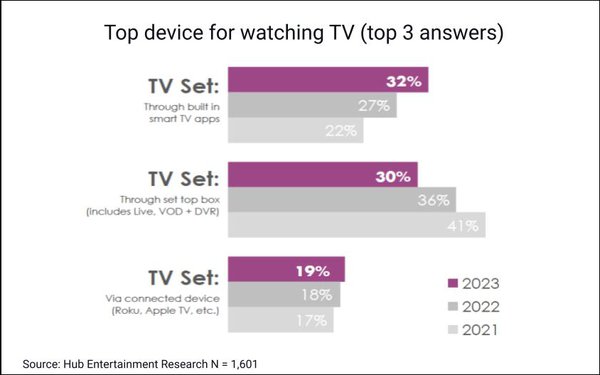SVODs Now Nearly Tied With Live TV As Viewers' Default Starting Point
- by Karlene Lukovitz @KLmarketdaily, September 13, 2023

Subscription-based video-on-demand services (SVODs) are now nearly tied with live TV as the first source viewers turn to when looking for something to watch, according to a new survey from Hub Entertainment Research.
While live TV was still found to be the top viewing default source among 46% of U.S. consumers with broadband, it now leads SVODs as a whole by just a single percentage point. Together, the “Big 5” SVODs — Netflix, Hulu, Amazon Prime Video, Disney+ and HBO/Max — were cited as the default by 40%, and other SVODs by an additional 5%, for a total of 45% (chart above).
“Live TV,” which was defined as including cable/satellite (multiplatform video programming distributors/MVPDs), virtual MVPDs and antenna (over the air/OTA), is down from 62% in 2018, while the Big 5 and other SVODs are up from 30% and zero percent in 2018.
advertisement
advertisement
Separately, asked about whether they use any online source — SVOD or other — as their default, 60% indicated online sources (up 8 percentage points from 2021) versus just 32% saying that MVPDs/set-top-boxes are their defaults (down 7 percentage points from 2021). In other words, the gap has increased to 28 points, from 13 points, just two years ago.

In just the past two years, smart TV apps have caught up with set-top boxes as viewers’ starting point.In 2021, almost twice as many viewers started to watch through a set-top box as chose a built-in smart TV app. Currently, however, those two sources are on par as the default. It’s also noteworthy that viewers are sticking with their connected devices, which have shown no decline as a home base over the past two years.

The results show that live sports and news are critical in the decision to use MVPDs and vMVPDs as default viewing sources—confirming their importance in anchoring the remaining subscribers to traditional pay-TV services.

While Netflix remains the SVOD source most likely to trump MVPDs as a default, other SVODs — Hulu and Max, in particular — have significantly impinged on that advantage:

The survey confirmed that consumers are considerably more loyal to their default TV sources—a key point for MVPDs (see the importance of sports/news in MVPD default decisions), as well as SVODs.
For example, most who default to a Big 5 SVOD or live TV on an MVPD say it is the provider they would retain if they could keep only one source.

“Variety" was the No. 1 reason cited for choosing Netflix and Prime Video as a default, while “favorite shows” was the most-cited reason among those choosing Hulu, Disney+ or Max as their default.
Asked about which sources they use in a given viewing scenario, Netflix was found to be most associated with viewing with a significant other, while other SVODs were most associated with escaping the day-to-day (Max and Prime Video), catching up on shows (Hulu), or watching with the family (Disney+).
Hub surveyed a census-balanced sample of 1,601 U.S. consumers 16 to 74 in August. All have broadband and watch at least one hour of TV per week.


